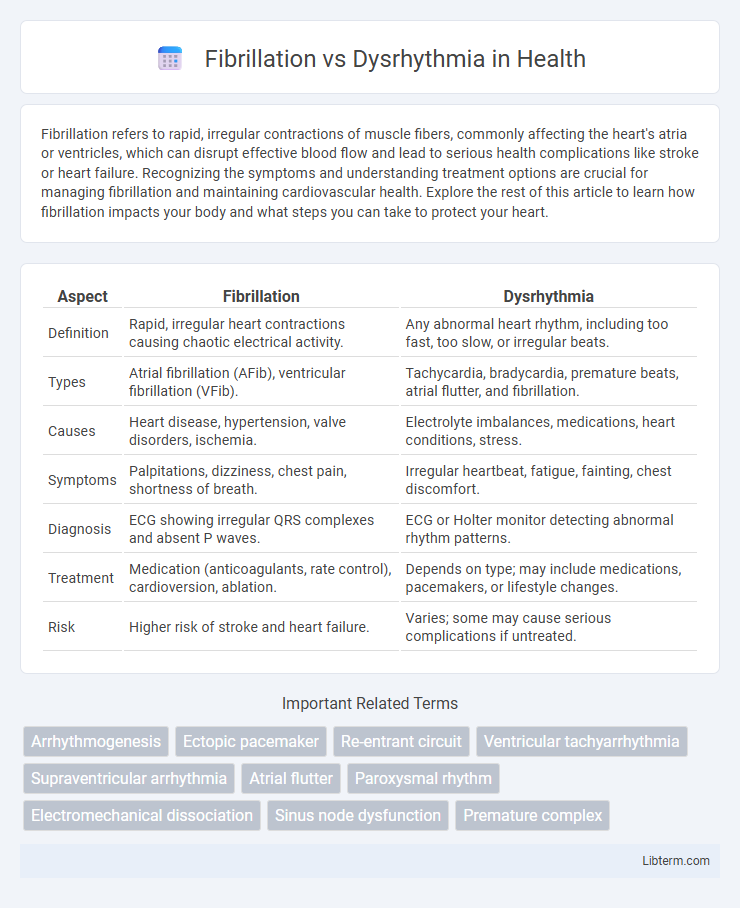Fibrillation refers to rapid, irregular contractions of muscle fibers, commonly affecting the heart's atria or ventricles, which can disrupt effective blood flow and lead to serious health complications like stroke or heart failure. Recognizing the symptoms and understanding treatment options are crucial for managing fibrillation and maintaining cardiovascular health. Explore the rest of this article to learn how fibrillation impacts your body and what steps you can take to protect your heart.
Table of Comparison
| Aspect | Fibrillation | Dysrhythmia |
|---|---|---|
| Definition | Rapid, irregular heart contractions causing chaotic electrical activity. | Any abnormal heart rhythm, including too fast, too slow, or irregular beats. |
| Types | Atrial fibrillation (AFib), ventricular fibrillation (VFib). | Tachycardia, bradycardia, premature beats, atrial flutter, and fibrillation. |
| Causes | Heart disease, hypertension, valve disorders, ischemia. | Electrolyte imbalances, medications, heart conditions, stress. |
| Symptoms | Palpitations, dizziness, chest pain, shortness of breath. | Irregular heartbeat, fatigue, fainting, chest discomfort. |
| Diagnosis | ECG showing irregular QRS complexes and absent P waves. | ECG or Holter monitor detecting abnormal rhythm patterns. |
| Treatment | Medication (anticoagulants, rate control), cardioversion, ablation. | Depends on type; may include medications, pacemakers, or lifestyle changes. |
| Risk | Higher risk of stroke and heart failure. | Varies; some may cause serious complications if untreated. |
Understanding Fibrillation and Dysrhythmia
Fibrillation refers to rapid, irregular heartbeats caused by disorganized electrical signals in the atria or ventricles, leading to inefficient blood pumping. Dysrhythmia, a broader term encompassing any abnormal heart rhythm, includes fibrillation as well as other arrhythmias such as bradycardia and tachycardia. Understanding the specific electrical disturbances and their impact on cardiac function is crucial for accurate diagnosis and targeted treatment of fibrillation and various forms of dysrhythmia.
Key Differences Between Fibrillation and Dysrhythmia
Fibrillation refers to rapid, irregular, and unsynchronized contraction of muscle fibers, most commonly observed in atrial or ventricular fibrillation affecting the heart's rhythm. Dysrhythmia encompasses any abnormal heart rhythm, including bradycardia, tachycardia, and fibrillation, representing a broader category of arrhythmias with variable clinical implications. The key difference lies in fibrillation being a specific type of dysrhythmia characterized by chaotic electrical activity, whereas dysrhythmia denotes any deviation from the normal cardiac rhythm.
Types of Fibrillation
Atrial fibrillation and ventricular fibrillation represent the primary types of fibrillation, distinguished by their origin within the heart's chambers. Atrial fibrillation involves rapid, irregular electrical signals in the atria, often leading to an increased risk of stroke. Ventricular fibrillation, a more critical condition, involves erratic electrical activity in the ventricles, resulting in ineffective heartbeats and potential sudden cardiac arrest.
Types of Dysrhythmia
Dysrhythmia encompasses various types of abnormal heart rhythms including atrial fibrillation, ventricular tachycardia, and bradycardia, each affecting heart rate and rhythm differently. Atrial fibrillation, a common type of dysrhythmia, causes rapid, irregular beating of the atria, increasing stroke risk. Ventricular tachycardia involves fast heartbeats originating from the ventricles, potentially leading to sudden cardiac arrest if untreated.
Causes and Risk Factors
Fibrillation, including atrial and ventricular types, is caused primarily by abnormal electrical impulses resulting in rapid, irregular heartbeats, often triggered by conditions like hypertension, coronary artery disease, or heart valve disorders. Dysrhythmia, a broader category of heart rhythm abnormalities, can stem from electrolyte imbalances, drug toxicity, or structural heart changes such as cardiomyopathy and myocardial infarction. Both conditions share risk factors including age, high blood pressure, obesity, diabetes, and excessive alcohol consumption, which contribute to their onset and progression.
Common Symptoms and Signs
Fibrillation, including atrial and ventricular types, commonly presents with irregular, rapid heartbeat, palpitations, fatigue, and shortness of breath. Dysrhythmia, a broader category of abnormal heart rhythms, often manifests through symptoms such as dizziness, chest pain, and syncope (fainting). Both conditions can lead to noticeable changes in pulse rate and rhythm, requiring timely diagnosis and management to prevent complications.
Diagnostic Approaches
Fibrillation, characterized by rapid and irregular heartbeats, is commonly diagnosed using electrocardiogram (ECG) monitoring, which identifies erratic electrical activity and lack of organized atrial contractions. Dysrhythmia diagnosis employs a range of tools including Holter monitors, event recorders, and implantable loop recorders to capture intermittent or transient arrhythmias. Advanced techniques such as electrophysiological studies (EPS) provide detailed mapping of abnormal conduction pathways, crucial for differentiating between various types of dysrhythmias and fibrillation.
Treatment Options
Treatment options for fibrillation often involve anticoagulants to reduce stroke risk, rate control medications such as beta-blockers or calcium channel blockers, and rhythm control strategies including electrical cardioversion and antiarrhythmic drugs. Dysrhythmia treatment depends on the specific type and severity, ranging from lifestyle modifications and pharmacologic agents like beta-blockers and calcium channel blockers to more invasive procedures including catheter ablation and implantable devices like pacemakers or defibrillators. Both conditions may require continuous monitoring and individualized management plans developed by cardiologists to optimize therapeutic outcomes and prevent complications.
Complications and Prognosis
Fibrillation, characterized by rapid and irregular heartbeats, significantly increases the risk of stroke and heart failure due to inefficient blood flow and clot formation. Dysrhythmia encompasses a broad range of abnormal heart rhythms, with complications varying from benign palpitations to life-threatening conditions like sudden cardiac arrest. Prognosis depends on the specific type and severity of the arrhythmia, with fibrillation often requiring aggressive management to reduce morbidity and mortality.
Prevention and Lifestyle Considerations
Effective prevention of fibrillation and dysrhythmia centers on maintaining heart health through a balanced diet rich in omega-3 fatty acids, regular cardiovascular exercise, and managing stress levels to reduce arrhythmia risk. Monitoring blood pressure, avoiding excessive alcohol intake, and eliminating tobacco use significantly lower the incidence of both atrial fibrillation and other dysrhythmias. Routine medical check-ups and adherence to prescribed medications for conditions like hypertension and diabetes are critical lifestyle considerations to prevent the onset or worsening of cardiac rhythm disorders.
Fibrillation Infographic

 libterm.com
libterm.com